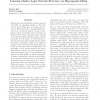Free Online Productivity Tools
i2Speak
i2Symbol
i2OCR
iTex2Img
iWeb2Print
iWeb2Shot
i2Type
iPdf2Split
iPdf2Merge
i2Bopomofo
i2Arabic
i2Style
i2Image
i2PDF
iLatex2Rtf
Sci2ools
ICML
2009
IEEE
2009
IEEE
Learning Markov logic network structure via hypergraph lifting
Markov logic networks (MLNs) combine logic and probability by attaching weights to first-order clauses, and viewing these as templates for features of Markov networks. Learning MLN structure from a relational database involves learning the clauses and weights. The state-of-the-art MLN structure learners all involve some element of greedily generating candidate clauses, and are susceptible to local optima. To address this problem, we present an approach that directly utilizes the data in constructing candidates. A relational database can be viewed as a hypergraph with constants as nodes and relations as hyperedges. We find paths of true ground atoms in the hypergraph that are connected via their arguments. To make this tractable (there are exponentially many paths in the hypergraph), we lift the hypergraph by jointly clustering the constants to form higherlevel concepts, and find paths in it. We variabilize the ground atoms in each path, and use them to form clauses, which are evaluate...
Candidate Clauses | First-order Clauses | ICML 2009 | Machine Learning | State-of-the-art Mln Structure |
| Added | 17 Nov 2009 |
| Updated | 17 Nov 2009 |
| Type | Conference |
| Year | 2009 |
| Where | ICML |
| Authors | Stanley Kok, Pedro Domingos |
Comments (0)

